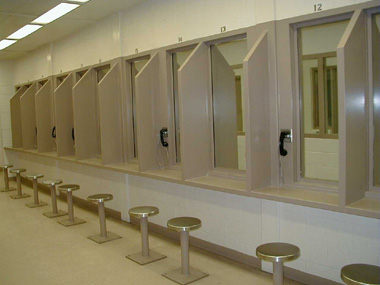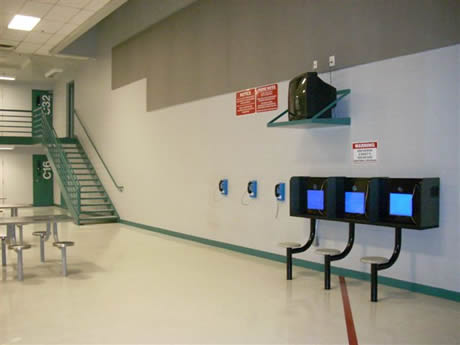In early August, 11 New York State corrections officers (COs) were at the scene of a medical emergency involving someone in custody at Collins Correctional Facility. All 11 were reportedly exposed to “suspected fentanyl,” became “gravely ill,” were given one or more doses of Narcan, were taken to a hospital, and recovered. The nurse attending to the patient did not appear similarly stricken, presumably because passive fentanyl exposure is only contagious to law enforcement.
“[I]t was by the grace of God that no lives were lost, although those on the scene report that the situations were dire,” Senator George Borello (R) wrote in an August 15 letter to Governor Kathy Hochul. “However, without intervention by your administration, it is only a matter of time until a fatality occurs … That is why we urge you to take action immediately by replacing full-contact visits with non-contact visitation.”
The letter, signed by five other legislators, cited two similar incidents where all COs involved were hospitalized. They have also all recovered.
In a supporting statement, the New York State Correctional Officers and Police Benevolent Association claimed that due to exposure to unknown substances, COs were “going to the hospital every other day for doing their job.”
Passive exposure to fentanyl, from skin contact or breathing in secondhand particles in the air, is a myth. There are media reports of law enforcement officers administering Narcan to themselves or each other all the time, but that does not mean they were in any danger. It means they administered Narcan.
CO culture is to do this indiscriminately, without knowing how to properly administer Narcan nor identify an opioid overdose. In one of the other two New York incidents, for example, officers were administered Narcan following suspected exposure near a prisoner “behaving irrationally,” which is language COs often use to describe overdose involving synthetic cannabinoids. In an opioid overdose, which is the only kind that responds to Narcan, by definition the person is unresponsive.
On August 9, a mailroom supervisor at USP Atwater, a high-security Federal Bureau of Prisons facility in California, died at a local hospital after he reported feeling ill earlier that day. The cause of death is still unknown and has not been linked to exposure to any contraband drugs in the mailroom, but media and the BOP itself have characterized it that way. Visits at Atwater have been suspended.

In prisons and jails across the country, contact with the outside world is being steadily replaced with virtual contact. Used books; all books; CDs; greeting cards and postcards; photographs; all mail except legal mail. And visits. All of this is accomplished the same way: Take a physical form of connection to the outside world, say friends and family of prisoners are exploiting it to smuggle in dangerous synthetic drugs, and replace it with a digital version offered by private contractor for a small fee. Or just take it away.
Most of this crusade has focused on mail and on “full-contact” visits, in which loved ones sit around a table in a prison visit room a bit like a cafeteria. They might be allowed a 10-second hug or a five-second kiss, and hold hands above the table or hold their small children. “Non-contact” visits happen from the other side of a Plexiglass window.
Paring away mail or books has often coincided with the arrival of tablets, or the promise of future tablets, provided to prisoners through contracts with corrections industry giants like Securus Technologies. The tablets don’t host video visits—like Zoom, but glitchier and with lots of rules—but Securus also provides the kiosks that do. Songs, phone calls, electronic mail, video messages, photos and video visits are all fee-per-service, as is sending money.
The elimination of in-person visits in some prisons and jails has been linked to kickback schemes in which private contractors steer corrections departments toward the elimination of full-contact or in-person visits. Securus used to actually require jails to end in-person visits in order to use its video visits. These days it just leaves the decision to corrections departments.

No one in state or federal custody has a legal right to visitation, of any kind. The United Nations minimum standards for treatment of prisoners, better known as the Mandela Rules, hold that someone cut off from the outside world is already being punished by the loss of self-determination, and therefore the system should not needlessly “aggravate the suffering inherent in such a situation.” They specify a right to receive visits “in addition to” digital forms of contact. But prisons and jails aren’t legally obligated by this kind of thing.
Some states, like California, Illinois and Massachusetts, have enacted legislation prohibiting prisons and jails from replacing in-person visits with video visits. For the past five years, the New York State Senate has advanced a bill to protect in-person visits in state institutions. Each year the legislative session has ended without voting on it.
In-person visits are already discouraged in a litany of ways. Remote prison locations that require hours of commuting each way; pat searches based on scanners with very narrow ideas of what a “normal” human body looks like; being on edge from not being able to smoke or vape all day, often surrounded by COs on edge from the same; vending machines that sell $5 bottles of milk.
Securus has promoted its video visits as a convenient alternative to non-contact visits, telling visitors that the 30-minute video sessions “are similar to standard through-the-glass visitation except that you will travel to the jail and visit with your incarcerated loved one using a touchscreen terminal located at the correctional facility’s visitation center. The benefit of Onsite video is that you can schedule your visit online in advance.”
Securus markets its its mail digitization services, however, to a different audience—promising that automation “reduces staffing costs” and offers the “ability to relocate staff to other critical areas.” Private contractors have a vested financial stake in drumming up fear around synthetic drugs, but they aren’t the only ones. Corrections departments do, too.
On a daily basis, COs face many of the same threats as the people in their custody—they spend their shift inside prison too. But they pass their breaking point and leave, because they have the option of doing so. The fewer COs show up each day, the more violent the prison becomes. Jails and especially prisons, both state and federal, are in a dire understaffing crisis that’s been deepening since the COVID-19 pandemic. Cutting prisoners off from their loved ones won’t fix this.
Full-contact visits require staff to screen the visitors at security, supervise everyone in the visit room and strip-search the person being visited. With non-contact visitors, staff mostly just has to check them in. Video visits technically require staff to monitor the video feed, but don’t really require staff at all.
Top image via Federal Bureau of Prisons. First inset image via Connecticut State Department of Correction. Second inset image via Davis County Sheriff’s Office.





Show Comments